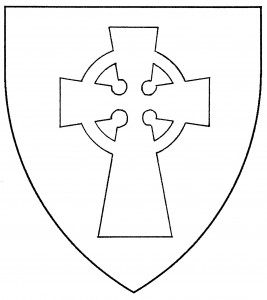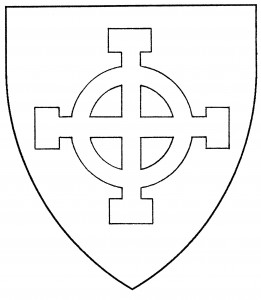The “Celtic cross” is found in Irish stone sculptures, dating from the 5th Century; it’s characterized by a thin annulet conjoined to the limbs, which are broad and either straight or slightly tapered, extending beyond the annulet. The most common form of Celtic cross in the Society is Latinate, with an elongated lower limb, but an equal-armed variant is also found. These remain registerable as “Celtic crosses”.
In the past, the Society has also registered an “equal-armed Celtic cross” that was effectively a cross potent surmounted by an annulet; this form mimics a cross found in period heraldry, the arms of Cardinal St. Marie, 1413 [Conz.Const. lxxi], but with the annulet interlacing the cross potent. The latter remains registerable, but now is blazoned explicitly as a “cross potent interlaced with an annulet” and treated as two charges. The heraldic difference between all these forms of Celtic cross is negligible.
Celtic crosses made by adding an annulet to another type of cross (e.g., a “Celtic cross moline”) are considered a step from period practice as of this writing. Modern depictions of the Celtic cross, where the annulet and cross are thin lines of equal width (like a gunsight) are not permitted.
Siobhan an Lochllanach bears: Sable, a Celtic cross argent atop a mount Or.
Etain ingen Ghilla Phatraic bears: Or, a Celtic cross per pale purpure and vert.
Morgana Swansdottir bears: Or, a Celtic cross equal armed, quarterly pierced and throughout vert.
Seamus Albanach Mac Roibeirt bears: Bendy sinister sable and argent, an equal-armed Celtic cross gules.

